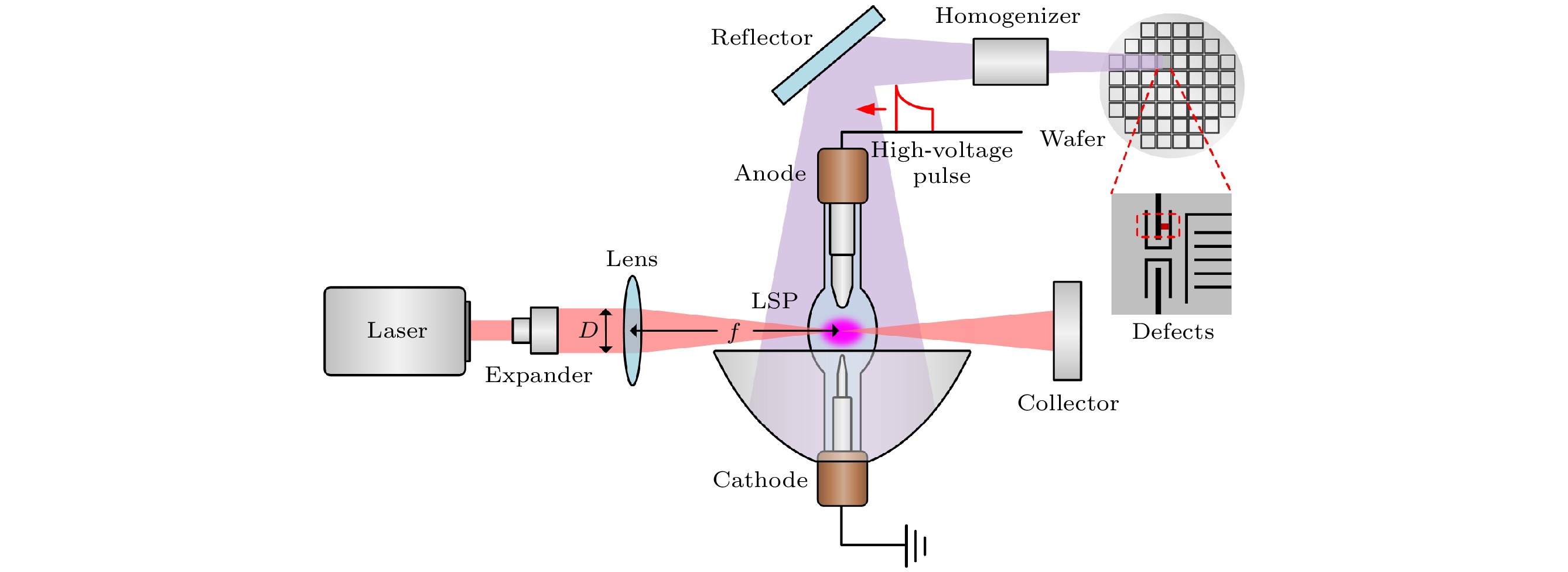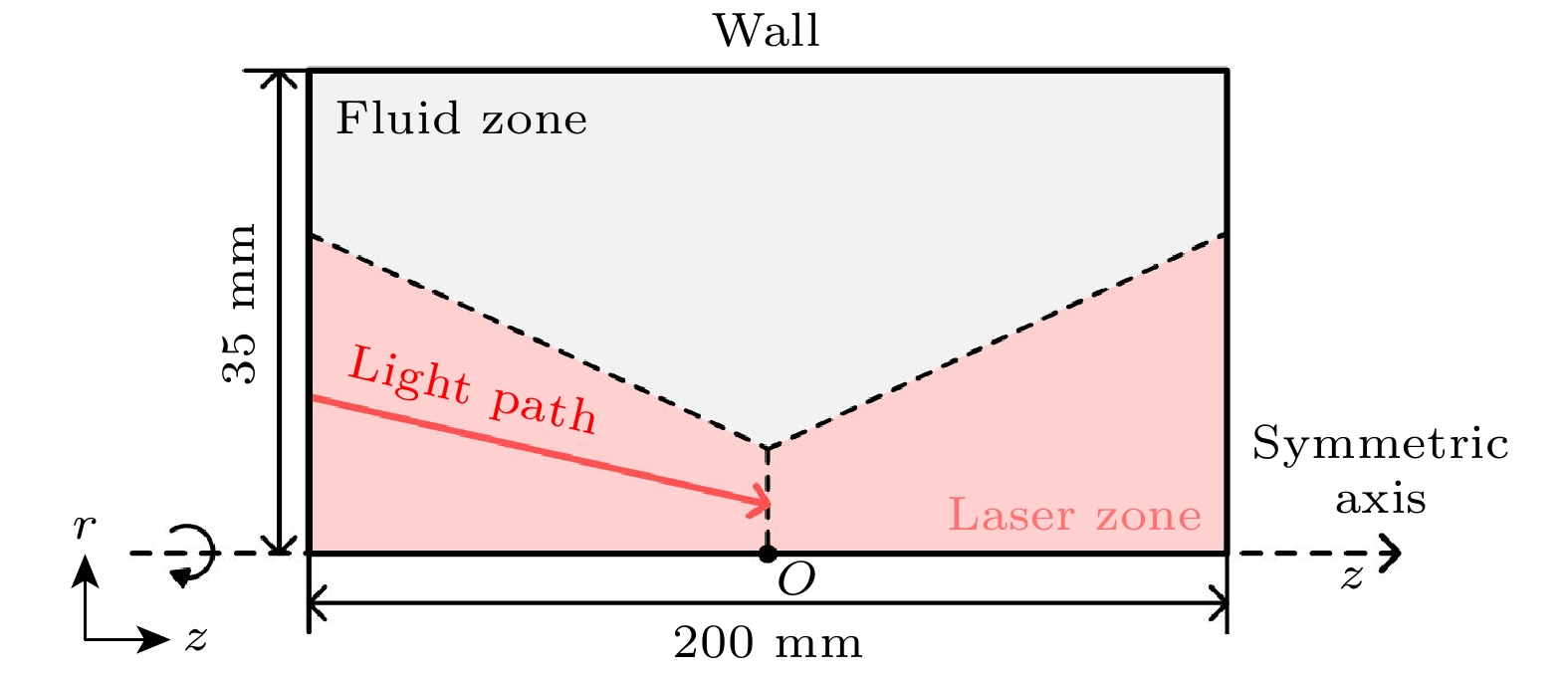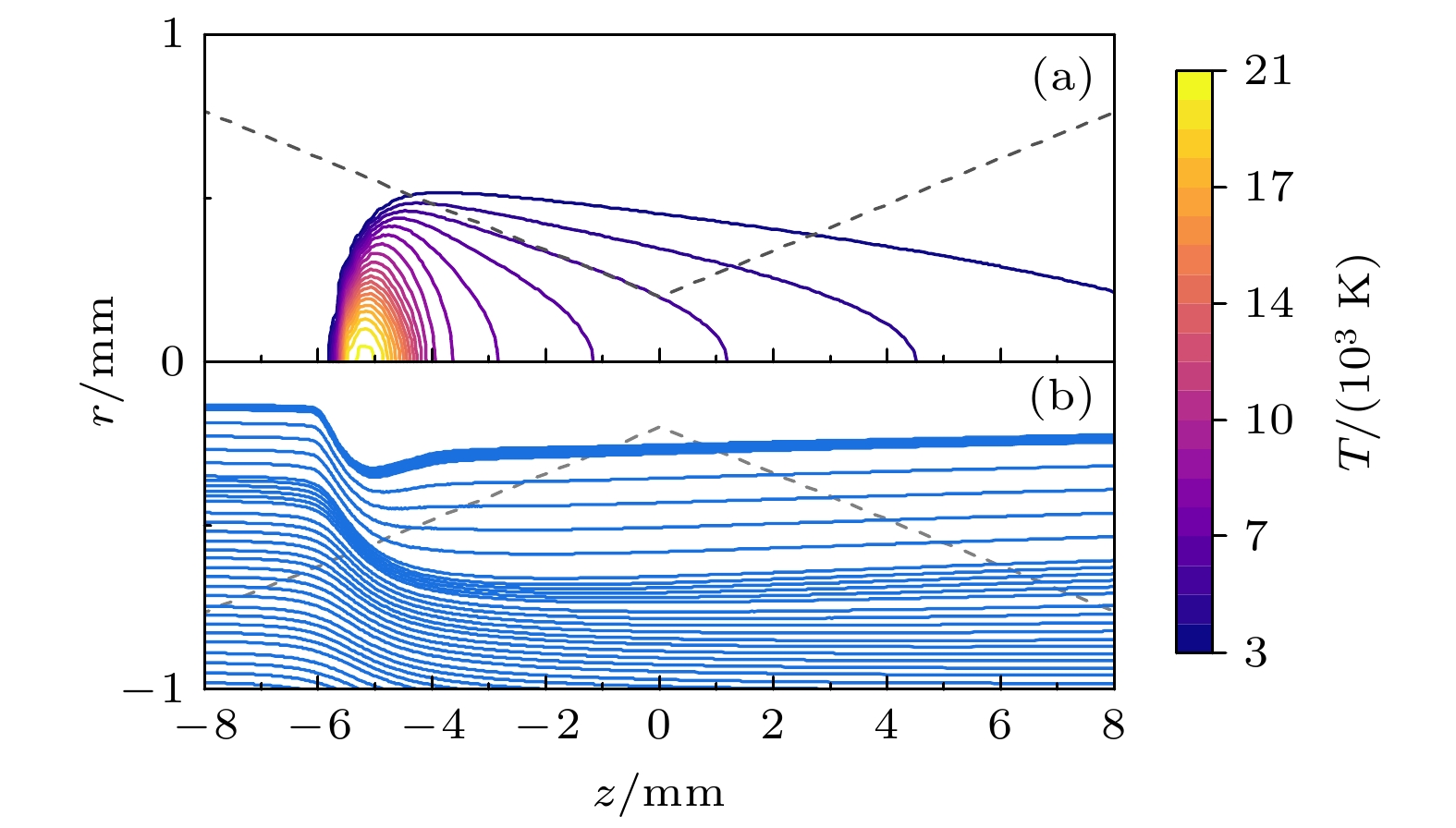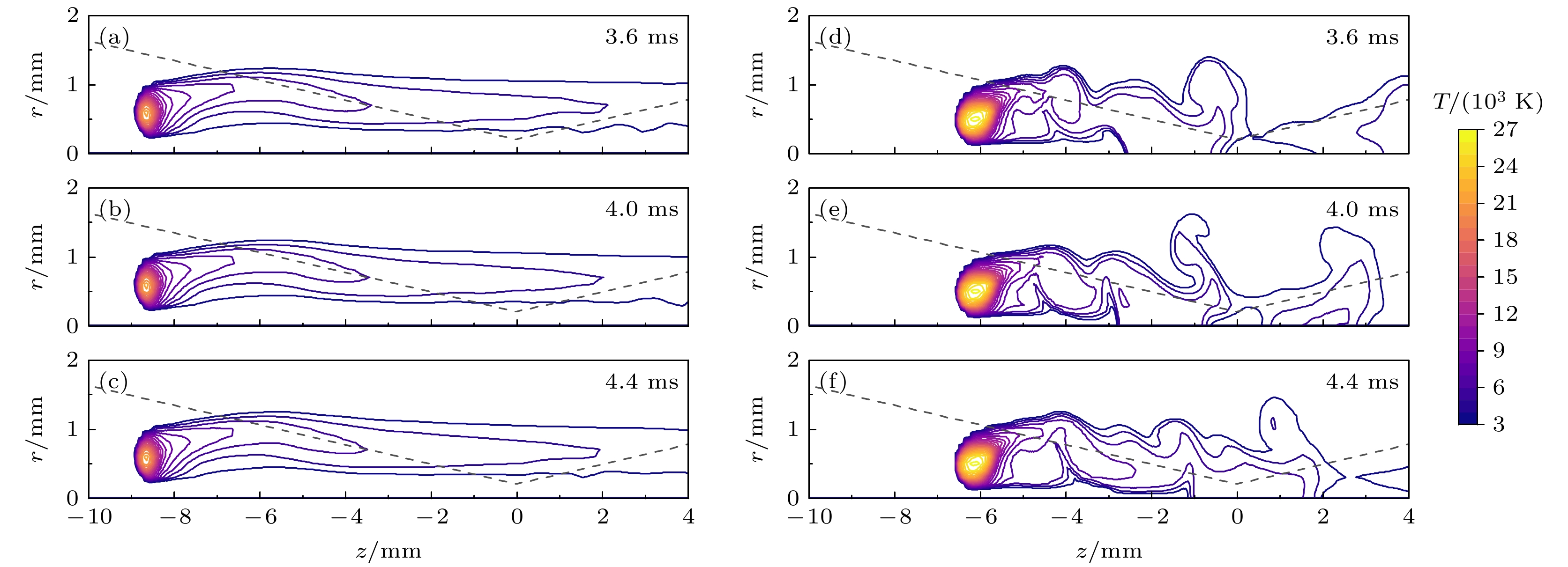-
激光维持等离子体作为一种光照强度高、光谱范围宽、发光稳定的新型辐射光源, 在光学检测(半导体晶圆检测)等领域具有重要的应用价值. 本文回顾了激光维持等离子体研究的发展历程, 介绍了其基本物理过程及数学描述方程, 建立了基于多物理场耦合的二维流体模型. 利用该模型研究了激光在等离子体中的传播过程, 探讨了激光维持等离子体的初始演化过程、能量注入机制、稳态特性及不稳定性等关键问题. 通过与高气压氙气等离子体实验结果对比, 确定了仿真模型的有效性. 相关仿真结果有助于深入理解激光维持等离子体的底层物理机制, 为实现光源系统设计、多参数优化提供理论依据.Laser-sustained plasma (LSP), which can be utilized for a novel radiation light source, has advantages such as high irradiance, broad spectral range, and stable emission, demonstrating significant applications in wafer inspection in the field of the semiconductor industry. This paper revisits the historical development of LSP research and introduces fundamental physical processes in LSP. The mathematical description equations for LSP and methods of calculating plasma parameters are provided, thereby a time-dependent two-dimensional fluid model is established by taking into consideration a laser-thermal-hydrodynamic coupling effect. The propagation of the laser in plasma is investigated based on the established model, and the fundamental processes in LSP, including the initial evolution process, laser energy deposition, steady-state characteristics, and instability, are explored. The effectiveness of the simulation model is confirmed through comparing with the experimental results of high-pressure Xe LSP. The findings indicate that the mode, power, F-number of incident lasers, as well as parameters including components, pressure, and flow velocity of gas, can all affect the steady-state properties of LSPs. Under the identical power and F-number conditions, Gaussian mode laser and annular mode laser both produce LSPs with different shapes and positions. Notably, under the conditions of high-power annular laser incidence, large laser F-number, and high flow velocity, the simulation results reveal temporal and spatial instability in LSP. These simulation results contribute significantly to a more in-depth understanding of the underlying physical mechanisms of the LSP. Furthermore, they provide a theoretical basis for designing the light source system and optimizing the multiple parameters. The influence of laser parameters on LSP properties elucidated in this study not only advances the fundamental understanding of LSP but also offers crucial insights for designing and optimizing the light source systems in various applications, particularly in the field of optical detection for semiconductor wafer inspection.
[1] Raizer Y P 1970 J. Exp. Theor. Phys. 31 1148
[2] Raizer Y P 1991 Gas Discharge Physics (Heidelberg: Springer) p415
[3] Raizer Y P 1980 Sov. Phys. Usp. 23 789
 Google Scholar
Google Scholar
[4] Kantrowitz A 1972 Astronaut. Aeronaut. 10 74
[5] Cremers D A, Archuleta F L, Martinez R J 1985 Spectrochim. Acta, Part B 40 665
 Google Scholar
Google Scholar
[6] Chen X, Mazumder J 1989 J. Appl. Phys. 66 5756
 Google Scholar
Google Scholar
[7] Bezel I, Delgado G, Derstine M, Gross K, Solarz R, Shchemelinin A, Shortt D 2015 Conference on Lasers and Electro-Optics (CLEO) San Jose, USA, May 10–15, 2015 pp1–2
[8] Islam M, Ciaffoni L, Hancock G, Ritchie G A 2013 Analyst 138 4741
 Google Scholar
Google Scholar
[9] Horne S, Smith D, Besen M, Partlow M, Stolyarov D, Zhu H, Holber W 2010 Next-Generation Spectroscopic Technologies III (SPIE) Orlando, USA, April 5–6, 2010 pp105–111
[10] Bezel I, Zvedenuk L B, Stepanov A E, KRerikh V, Potapkin B V US Patent US11776804 B2[2023-10-03
[11] Bezel I, Zvedenuk L B, Stepanov A E, Torkaman A 2023 US Patent 2023/0053035 A1 [2023-02-16
[12] Generalov N A, Zimakov V P, Kozlov G I, Masyukov V A, Raizer Y P 1970 Sov. J. Exp. Theor. Phys. 11 302
[13] 王海兴, 陈熙 2004 工程热 25 S1
Wang H X, Chen X 2004 J. Eng. Thermophys. 25 S1
[14] 郑志远, 鲁欣, 张杰, 郝作强, 远晓辉, 王兆华 2005 54 192
 Google Scholar
Google Scholar
Zheng Z Y, Lu X, Zhang J, Hao Z Q, Yuan X H, Wang Z H 2005 Acta. Phys. Sin. 54 192
 Google Scholar
Google Scholar
[15] Krier H, Mazumder J, Rockstroh T, Bender T, Glumb R 1986 AIAA J. 24 1656
 Google Scholar
Google Scholar
[16] Shi Z, Yang S, Yu F, Yu X 2023 Opt. Express 31 6132
 Google Scholar
Google Scholar
[17] Akarapu R, Nassar A R, Copley S M, Todd J A 2009 J. Laser Appl. 21 169
 Google Scholar
Google Scholar
[18] Fowler M C, Smith D C 1975 J. Appl. Phys. 46 138
 Google Scholar
Google Scholar
[19] Zimakov V P, Kuznetsov V A, Solovyov N G, Shemyakin A N, Shilov A O, Yakimov M Y 2016 Plasma Phys. Rep. 42 68
 Google Scholar
Google Scholar
[20] Hu Y, Wang X, Zuo D 2022 Vacuum 203 111229
 Google Scholar
Google Scholar
[21] Gerasimenko M V, Kozlov G I, Kuznetsov V A 1983 Sov. J. Quantum Electron. 13 438
 Google Scholar
Google Scholar
[22] Welle R, Keefer D, Peters C 1987 AIAA J. 25 1093
 Google Scholar
Google Scholar
[23] Jeng S M, Keefer D 1989 J. Propul. Power 5 577
 Google Scholar
Google Scholar
[24] Liu J B, Zhang D H Y, Fu Y Y 2023 New J. Phys.25 122001  Google Scholar
Google Scholar
Liu J B, Zhang D H Y, Fu Y Y 2023 New J. Phys. 25 122001
 Google Scholar
Google Scholar
[25] Jeng S M, Keefer D R 1987 J. Propul. Power 3 255
 Google Scholar
Google Scholar
[26] Batteh J H, Keefer D R 1974 IEEE Trans. Plasma Sci. 2 122
 Google Scholar
Google Scholar
[27] Glumb R J, Krier H 1984 J. Spacecr. Rockets 21 70
 Google Scholar
Google Scholar
[28] Molvik G A, Choi D, Merkle C L 1985 AIAA J. 23 1053
 Google Scholar
Google Scholar
[29] Merkle C L, Molvik G A, Shaw E J H 1986 J. Propul. Power 2 465
 Google Scholar
Google Scholar
[30] Jeng S M, Keefer D R, Welle R, Peters C E 1987 AIAA J. 25 1224
 Google Scholar
Google Scholar
[31] Conrad R, Raizer Y P, Sarzhikov S T 1996 AIAA J. 34 1584
 Google Scholar
Google Scholar
[32] Rafatov I R, Yedierler B, Kulumbaev E B 2009 J. Phys. D: Appl. Phys. 42 055212
 Google Scholar
Google Scholar
[33] Keefer D R, Henriksen B B, Braerman W F 1975 J. Appl. Phys. 46 1080
 Google Scholar
Google Scholar
[34] Generalov N A, Zakharov A M, Kosynkin V D, Yakimov M Y 1986 Combust., Explos. Shock Waves 22 214
 Google Scholar
Google Scholar
[35] Rafatov I 2009 Phys. Lett. A 373 3336
 Google Scholar
Google Scholar
[36] Zimakov V P, Kuznetsov V A, Solovyov N G, Shemyakin A N, Shilov A O, Yakimov M Y 2017 J. Phys. Conf. Ser. 815 012003
 Google Scholar
Google Scholar
[37] Zimakov V P, Lavrentyev S, Solovyov N, Shemyakin A, Yakimov M A 2019 Physical-Chemical Kinetics in Gas Dynamics 19 1
[38] Lavrentyev S Y, Solovyov N G, Shemyakin A N, Yu Yakimov M 2019 J. Phys. Conf. Ser. 1394 012012
 Google Scholar
Google Scholar
[39] Kotov M A, Lavrentyev S Y, Shemyakin A N, Solovyov N G, Yakimov M Y 2022 Plasma Sources Sci. Technol. 31 124002
 Google Scholar
Google Scholar
[40] 王海兴, 孙素蓉, 陈士强 2012 61 195203
 Google Scholar
Google Scholar
Wang H X, Sun S R, Chen S Q 2012 Acta. Phys. Sin. 61 195203
 Google Scholar
Google Scholar
[41] 陈艳秋 2014 63 205201
 Google Scholar
Google Scholar
Chen Y Q 2014 Acta. Phys. Sin. 63 205201
 Google Scholar
Google Scholar
[42] Gordon S, McBride B J 1994 Computer Program for Calculation of Complex Chemical Equilibrium Compositions and Applications. part 1: Analysis. Tech. Rep. 95 N20180, NASA
[43] Johnston T W, Dawson J M 1973 Phys. Fluids 16 722
 Google Scholar
Google Scholar
[44] Gilleron F, Piron R 2015 High Energy Density Phys. 17 219
 Google Scholar
Google Scholar
[45] Chapman S, Cowling T G 1995 The Mathematical Theory of Non-Uniform Gases: An Account of the Kinetic Theory of Viscosity, Thermal Conduction, and Diffusion in Gases (3rd Ed.) (Cambridge: Cambridge University Press) p167
[46] Adibzadeh M, Theodosiou C E 2005 At. Data Nucl. Data Tables 91 8
 Google Scholar
Google Scholar
[47] Amdur I, Mason E 1958 Phys. Fluids 1 370
 Google Scholar
Google Scholar
[48] Miller J S, Pullins S H, Levandier D J, Chiu Y h, Dressler R A 2002 J. Appl. Phys. 91 984
 Google Scholar
Google Scholar
[49] Mason E, Munn R, Smith F J 1967 Phys. Fluids 10 1827
 Google Scholar
Google Scholar
[50] Tang K, Toennies J P 1984 J. Chem. Phys. 80 3726
 Google Scholar
Google Scholar
[51] Tang K, Toennies J P 1986 Z. Phys. D: At. Mol. Clusters 1 91
 Google Scholar
Google Scholar
[52] Monchick L 1959 Phys. Fluids 2 695
 Google Scholar
Google Scholar
[53] Hirschfelder J, Curtiss C, Bird R, Mayer M 1954 Molecular Theory of Gases and Liquids (New York: Wiley) pp1126–1127
[54] Devoto R S 1967 Phys. Fluids 10 354
 Google Scholar
Google Scholar
[55] Devoto R S 1967 Phys. Fluids 10 2105
 Google Scholar
Google Scholar
[56] Horn K P 1966 Radiative Behavior of Shock Heated Argon Plasma Flows (Stanford: Stanford University) p35
[57] 杜世刚 1998 等离子体物理 (北京: 原子能出版社) 第162页
Du S G 1998 Plasma Physics (Beijing: Atomic Press) p162
[58] COMSOL Multiphysics® v. 6.0. cn.comsol.com. COMSOL AB, Stockholm, Sweden.
[59] 过增元, 赵文华 1986 电弧和热等离子体(北京: 科学出版社) 第141—157页
Guo Z Y, Zhao W H 1986 Arc and Thermal Plasma (Beijing: Science Press) pp141–157
-
图 2 $ {\rm{{CO_2}}} $激光条件下LSP中主要能量传递机制, 包括: 逆韧致辐射(ff)吸收; 自由-自由(ff)/自由-束缚(fb)辐射; 束缚-束缚(bb)辐射; 热扩散
Fig. 2. Main energy transfer processes of plasma sustained by $ {\rm{{CO_2}}} $ laser including bremsstrahlung absorption, free-free (ff)/free-bound (fb) emission, bound-bound (bb) emission, and thermal diffusion.
图 10 高功率、高气体流速下产生的不稳定LSP. 图中结果的气体压强均为$ 10{\rm{\, {atm}}} $, 采用环形激光, 功率为$ 5000{\rm{\, {W}}} $, F数为$ f/3.5 $. 图(a)—(c)展示了入口流速设置为$ 10{\rm{\, {m/s}}} $产生的LSP在$ 3.6 $, $ 4.0$和$ 4.4{\rm{~{ms}}} $的二维温度分布; 图(d)—(f)展示了入口流速设置为$ 20{\rm{\, {m/s}}} $产生的LSP在$ 3.6$, $ 4.0$和$ 4.4{\rm{~{ms}}} $的二维温度分布
Fig. 10. Unstable LSP generated under the condition of high laser power and high gas velocity. The gas pressure for all the results is set to $ 10{\rm{\, {atm}}} $. The laser power is $ 5000{\rm{\, {W}}} $ and F-number equals to $ f/3.5 $. Panels (a)–(c) show the two-dimensional temperature distribution of the LSP when inlet velocity is set to $ 10{\rm{\, {m/s}}} $ at $ 3.6 $, $ 4.0 $, and $ 4.4{\rm{~{ms}}} $. Panels (d)–(f) show the two-dimensional temperature distribution of the LSP when inlet velocity is set to $ 20{\rm{\, {m/s}}} $ at $ 3.6 $, $ 4.0 $, and $ 4.4{\rm{~{ms}}} $.
图 8 (a)相同功率下高斯模式与环形模式激光相对强度径向分布; (b), (c)激光模式对稳态LSP温度分布的影响, 分别为$ f/7 $条件下高斯光束与环形光束结果. 模拟条件为5 atm的Xe环境下, 入射激光功率为500 W, F数为$ f/7 $, 气体流速10 m/s
Fig. 8. (a) Radial distribution of relative laser intensity of Gaussian beam and annular beam at a same laser power; (b), (c) effects of laser mode on steady LSP temperature distribution, where (b) and (c) are the results of Gaussian beam and annular beam at $ f/7 $, respectively. Background gas: Xe, pressure: 5 atm, laser power: 500 W, F-number: $ f/7 $, velocity: 10 m/s.
图 9 不同时刻LSP的温度分布图. 模拟条件为$ 5{\rm{\, {atm}}} $的Xe环境下, 入射激光功率为$ 500{\rm{\, {W}}} $, F数为$ f/7 $, 气体流速为$ 10{\rm{\, {m/s}}} $
Fig. 9. Temperature distributions of LSP at different times during laser propagation. Background gas: Xe, pressure: $ 5{\rm{\, {atm}}} $, laser power: $ 500{\rm{\, {W}}} $, F-number: $ f/7 $, velocity: $ 10{\rm{\, {m/s}}} $.
表 1 输运系数与用于计算的碰撞积分
Table 1. Transport coefficients and the collision integrals used for calculation
输运系数 用于计算的碰撞积分 $ \mu_{\rm{{v}}} $ $ \varOmega^{\left({1, 1}\right)} $; $ \varOmega^{\left({2, 2}\right)} $ $ k_{\rm{{T}}} $ $ \varOmega^{\left({1, s}\right)}, \, s = 1,\cdots, 5 $; $ \varOmega^{\left({2, s}\right)}, \, s = 2, 3, 4 $ 表 2 Xe等离子体中粒子对相互作用对应的碰撞积分计算方法
Table 2. Calculation of collisional integrals corresponding to particle pair interactions in Xe plasmas.
表 3 模型控制方程及对应边界条件
Table 3. Control equations and boundary conditions of the model.
-
[1] Raizer Y P 1970 J. Exp. Theor. Phys. 31 1148
[2] Raizer Y P 1991 Gas Discharge Physics (Heidelberg: Springer) p415
[3] Raizer Y P 1980 Sov. Phys. Usp. 23 789
 Google Scholar
Google Scholar
[4] Kantrowitz A 1972 Astronaut. Aeronaut. 10 74
[5] Cremers D A, Archuleta F L, Martinez R J 1985 Spectrochim. Acta, Part B 40 665
 Google Scholar
Google Scholar
[6] Chen X, Mazumder J 1989 J. Appl. Phys. 66 5756
 Google Scholar
Google Scholar
[7] Bezel I, Delgado G, Derstine M, Gross K, Solarz R, Shchemelinin A, Shortt D 2015 Conference on Lasers and Electro-Optics (CLEO) San Jose, USA, May 10–15, 2015 pp1–2
[8] Islam M, Ciaffoni L, Hancock G, Ritchie G A 2013 Analyst 138 4741
 Google Scholar
Google Scholar
[9] Horne S, Smith D, Besen M, Partlow M, Stolyarov D, Zhu H, Holber W 2010 Next-Generation Spectroscopic Technologies III (SPIE) Orlando, USA, April 5–6, 2010 pp105–111
[10] Bezel I, Zvedenuk L B, Stepanov A E, KRerikh V, Potapkin B V US Patent US11776804 B2[2023-10-03
[11] Bezel I, Zvedenuk L B, Stepanov A E, Torkaman A 2023 US Patent 2023/0053035 A1 [2023-02-16
[12] Generalov N A, Zimakov V P, Kozlov G I, Masyukov V A, Raizer Y P 1970 Sov. J. Exp. Theor. Phys. 11 302
[13] 王海兴, 陈熙 2004 工程热 25 S1
Wang H X, Chen X 2004 J. Eng. Thermophys. 25 S1
[14] 郑志远, 鲁欣, 张杰, 郝作强, 远晓辉, 王兆华 2005 54 192
 Google Scholar
Google Scholar
Zheng Z Y, Lu X, Zhang J, Hao Z Q, Yuan X H, Wang Z H 2005 Acta. Phys. Sin. 54 192
 Google Scholar
Google Scholar
[15] Krier H, Mazumder J, Rockstroh T, Bender T, Glumb R 1986 AIAA J. 24 1656
 Google Scholar
Google Scholar
[16] Shi Z, Yang S, Yu F, Yu X 2023 Opt. Express 31 6132
 Google Scholar
Google Scholar
[17] Akarapu R, Nassar A R, Copley S M, Todd J A 2009 J. Laser Appl. 21 169
 Google Scholar
Google Scholar
[18] Fowler M C, Smith D C 1975 J. Appl. Phys. 46 138
 Google Scholar
Google Scholar
[19] Zimakov V P, Kuznetsov V A, Solovyov N G, Shemyakin A N, Shilov A O, Yakimov M Y 2016 Plasma Phys. Rep. 42 68
 Google Scholar
Google Scholar
[20] Hu Y, Wang X, Zuo D 2022 Vacuum 203 111229
 Google Scholar
Google Scholar
[21] Gerasimenko M V, Kozlov G I, Kuznetsov V A 1983 Sov. J. Quantum Electron. 13 438
 Google Scholar
Google Scholar
[22] Welle R, Keefer D, Peters C 1987 AIAA J. 25 1093
 Google Scholar
Google Scholar
[23] Jeng S M, Keefer D 1989 J. Propul. Power 5 577
 Google Scholar
Google Scholar
[24] Liu J B, Zhang D H Y, Fu Y Y 2023 New J. Phys.25 122001  Google Scholar
Google Scholar
Liu J B, Zhang D H Y, Fu Y Y 2023 New J. Phys. 25 122001
 Google Scholar
Google Scholar
[25] Jeng S M, Keefer D R 1987 J. Propul. Power 3 255
 Google Scholar
Google Scholar
[26] Batteh J H, Keefer D R 1974 IEEE Trans. Plasma Sci. 2 122
 Google Scholar
Google Scholar
[27] Glumb R J, Krier H 1984 J. Spacecr. Rockets 21 70
 Google Scholar
Google Scholar
[28] Molvik G A, Choi D, Merkle C L 1985 AIAA J. 23 1053
 Google Scholar
Google Scholar
[29] Merkle C L, Molvik G A, Shaw E J H 1986 J. Propul. Power 2 465
 Google Scholar
Google Scholar
[30] Jeng S M, Keefer D R, Welle R, Peters C E 1987 AIAA J. 25 1224
 Google Scholar
Google Scholar
[31] Conrad R, Raizer Y P, Sarzhikov S T 1996 AIAA J. 34 1584
 Google Scholar
Google Scholar
[32] Rafatov I R, Yedierler B, Kulumbaev E B 2009 J. Phys. D: Appl. Phys. 42 055212
 Google Scholar
Google Scholar
[33] Keefer D R, Henriksen B B, Braerman W F 1975 J. Appl. Phys. 46 1080
 Google Scholar
Google Scholar
[34] Generalov N A, Zakharov A M, Kosynkin V D, Yakimov M Y 1986 Combust., Explos. Shock Waves 22 214
 Google Scholar
Google Scholar
[35] Rafatov I 2009 Phys. Lett. A 373 3336
 Google Scholar
Google Scholar
[36] Zimakov V P, Kuznetsov V A, Solovyov N G, Shemyakin A N, Shilov A O, Yakimov M Y 2017 J. Phys. Conf. Ser. 815 012003
 Google Scholar
Google Scholar
[37] Zimakov V P, Lavrentyev S, Solovyov N, Shemyakin A, Yakimov M A 2019 Physical-Chemical Kinetics in Gas Dynamics 19 1
[38] Lavrentyev S Y, Solovyov N G, Shemyakin A N, Yu Yakimov M 2019 J. Phys. Conf. Ser. 1394 012012
 Google Scholar
Google Scholar
[39] Kotov M A, Lavrentyev S Y, Shemyakin A N, Solovyov N G, Yakimov M Y 2022 Plasma Sources Sci. Technol. 31 124002
 Google Scholar
Google Scholar
[40] 王海兴, 孙素蓉, 陈士强 2012 61 195203
 Google Scholar
Google Scholar
Wang H X, Sun S R, Chen S Q 2012 Acta. Phys. Sin. 61 195203
 Google Scholar
Google Scholar
[41] 陈艳秋 2014 63 205201
 Google Scholar
Google Scholar
Chen Y Q 2014 Acta. Phys. Sin. 63 205201
 Google Scholar
Google Scholar
[42] Gordon S, McBride B J 1994 Computer Program for Calculation of Complex Chemical Equilibrium Compositions and Applications. part 1: Analysis. Tech. Rep. 95 N20180, NASA
[43] Johnston T W, Dawson J M 1973 Phys. Fluids 16 722
 Google Scholar
Google Scholar
[44] Gilleron F, Piron R 2015 High Energy Density Phys. 17 219
 Google Scholar
Google Scholar
[45] Chapman S, Cowling T G 1995 The Mathematical Theory of Non-Uniform Gases: An Account of the Kinetic Theory of Viscosity, Thermal Conduction, and Diffusion in Gases (3rd Ed.) (Cambridge: Cambridge University Press) p167
[46] Adibzadeh M, Theodosiou C E 2005 At. Data Nucl. Data Tables 91 8
 Google Scholar
Google Scholar
[47] Amdur I, Mason E 1958 Phys. Fluids 1 370
 Google Scholar
Google Scholar
[48] Miller J S, Pullins S H, Levandier D J, Chiu Y h, Dressler R A 2002 J. Appl. Phys. 91 984
 Google Scholar
Google Scholar
[49] Mason E, Munn R, Smith F J 1967 Phys. Fluids 10 1827
 Google Scholar
Google Scholar
[50] Tang K, Toennies J P 1984 J. Chem. Phys. 80 3726
 Google Scholar
Google Scholar
[51] Tang K, Toennies J P 1986 Z. Phys. D: At. Mol. Clusters 1 91
 Google Scholar
Google Scholar
[52] Monchick L 1959 Phys. Fluids 2 695
 Google Scholar
Google Scholar
[53] Hirschfelder J, Curtiss C, Bird R, Mayer M 1954 Molecular Theory of Gases and Liquids (New York: Wiley) pp1126–1127
[54] Devoto R S 1967 Phys. Fluids 10 354
 Google Scholar
Google Scholar
[55] Devoto R S 1967 Phys. Fluids 10 2105
 Google Scholar
Google Scholar
[56] Horn K P 1966 Radiative Behavior of Shock Heated Argon Plasma Flows (Stanford: Stanford University) p35
[57] 杜世刚 1998 等离子体物理 (北京: 原子能出版社) 第162页
Du S G 1998 Plasma Physics (Beijing: Atomic Press) p162
[58] COMSOL Multiphysics® v. 6.0. cn.comsol.com. COMSOL AB, Stockholm, Sweden.
[59] 过增元, 赵文华 1986 电弧和热等离子体(北京: 科学出版社) 第141—157页
Guo Z Y, Zhao W H 1986 Arc and Thermal Plasma (Beijing: Science Press) pp141–157
计量
- 文章访问数: 6578
- PDF下载量: 418
- 被引次数: 0














 下载:
下载:









